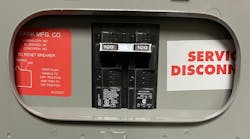Q. If the secondary conductors of a transformer are less than 10 feet in length, do the secondary conductors have to terminate in a main breaker?
A. You can run secondary conductors up to 10 feet without overcurrent protection, if they comply with 240.21(C)(2). However, you must provide overcurrent protection for lighting and appliance branch-circuit panelboards. This protection is required to be located on the secondary side of the transformer [408.36(D)], as shown in the Figure.



